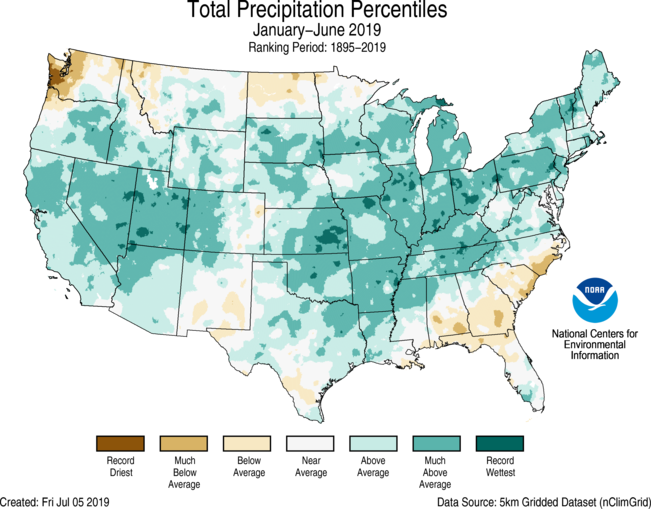July 2019 was the Earths warmest month in 139 years of recorded history. With June having been certified as Earth’s warmest June ever ever recorded, and October coming in at the 2nd hottest on record, 2019 as a whole stands to find it’s place within the top five warmest years on record, which would make the five hottest years on record the past five years. What is alarming in this particular circumstance is that it occurred without two usual influences on global climate: solar cycles and a strong El Nino. We are currently within the lowest period of a 100 year solar cycle, and the El Nino event of 2018-2019 was an exceptionally weak one, barely passing the required thresholds. High temperatures impact Florida agriculture in two broad ways: the effects of the heat itself, and the effects of the associated moisture levels. Today we address how increased moisture affects Florida agriculture.
Secondary Impacts: The rain rain rain came down down down…
Credit: NOAA/NCEI
After the heat itself, the other broad way that a warmer climate affects Florida agriculture is moisture. Warm air is able to hold more moisture than cold air. When storms do occur, they are able to access this excess moisture and create excess rainfall. This is also a good example of discerning weather – short-term events – from climate – the overall set of conditions that weather happens in. Weather is individual hands of poker. Climate is the deck. Climate change is you stacking the deck with extra aces to get higher hands. Stacking the deck doesn’t necessarily mean you’ll play more hands, but those aces increase the chance of high hands every time you do. June 2018-June 2019 has been straight flushes, the wettest 12 month period on record. While Florida had actually been fairly normal in terms of rainfall, many areas in the rest of the country saw near-record rain and flooding.
While it may seem counter-intuitive at first glance, this same phenomenon of increased atmospheric moisture leading to increased rainfall levels is why we can expect snowstorms to drop more snow in a warming climate. Remember, all you need for snow is adequate moisture and freezing temperatures. The “global warming” aspect of climate change does not mean the end of freezing temperatures; it means increased average global temperatures. Even if an area of land saw a 5 degree increase in average temperature, if that area’s normal winter temperature was 15 degrees, a 5 degree increase isn’t going to get you above freezing. It will, however, increase the amount of moisture that atmosphere can hold. People who live around the Great Lakes are well acquainted with this notion on a smaller scale. Dubbed “lake effect snow,” a storm that drops 6 inches of snow on Chicago can drop double that amount on the other side of Lake Michigan due to the warmer, moisture-rich air above the lake.
Plants of course need water to survive, but too much water can be deadly. With the notable exception of rice grown on the south shore of Lake Okeechobee, most Florida crops do not like to be in wet conditions for long. Roots need oxygen, and if they’re covered by water for too long the plant drowns. Even if the water does drain, rainfall is one of the primary methods that fungi and bacteria spread within a field. When raindrops splash against a leaf surface, bacteria and spores can hitch a ride on the exploding droplets that follow. This is also why we often recommend farms use sub-surface drip irrigation as opposed to overhead irrigation which simulates rainfall. Even without rain, the warm, moist air itself provides an idea climate for all kinds of pathogens to thrive. Those pathogens get a boost when the plant is stressed from heat, insect feeding, or a weak dormancy. Florida will be hit hard by climate change, and we’re going to have to be extremely innovative and resourceful to adapt.
 0
0
 Credit:
Credit: 